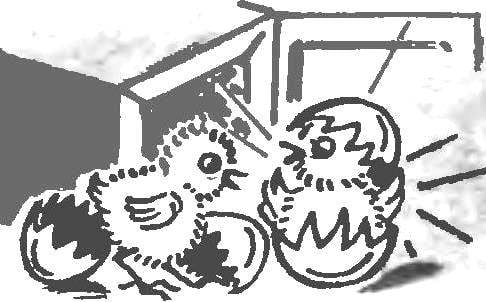To link it all together — functional incubator — will not make any difficulties even for novice homebrew (see illustration). When you enable the plug НР1 the network light up and immediately begin to warm the air in the working volume of the former refrigerator lamp EL1 — EL5. Set temperature is monitored electrocontact thermometer CT in the control circuit contactor-relay KR1. Upon reaching the desired value t°C this thermometer is triggered by applying power to the coil KR1. After being closed, contacts KR1 opens, de-energizing lamp EL1 — EL4. With the drop in temperature of electrocontact thermometer will shut off the coil of the contactor relay which, in turn, will again close the contacts KR1.1-3, and serves the power supply to the lamp EL1 — EL4. The process of heating the working volume of the incubator is repeated.
The purpose is constantly the lights EL5 — to ensure uniformity of heating of the eggs, creating the desired moisture content due to the intensification of evaporation of water in the cell and the surface of the wet tissue on the bottom shelf. In addition, the reduced frequency of the actuation of the contactor relays.
Before incubation the eggs are checked, selecting those that have the right shape (not triangular and not particularly round), clean, without scars and cracks the shell. The priority is given to the most recent, carried a maximum of 5-7 days ago in chickens, 10 days in turkeys and ducks from 15 days to have geese. The surface of the eggs Matt, as the top covering for her narcolepsy film. It has antibacterial properties, so washing eggs prior to incubation is not recommended.
The incubator is desirable to operate in a room where the temperature is maintained in the range 15-22°C. During the laying of the eggs to make sure the working volume of the camera was quite warm. To do this, as practice shows, the initial temperature should be 1-2°C greater than the temperature usually recommended for the initial period of incubation. For chicken eggs it lasts for 10-11 days. Incubation of ducklings and Turkey poults initial period is 13 days. For goose eggs — 15.
Fig. 2. Wiring diagram for a homemade incubator to the mains:
НР1 plug, FU1 — fuse fuse, 1 amp, EL5 — lamp constant uniform heating of the eggs (40 W), CP1 — thermometer electric contact, KR1 is the winding of the contactor relays CR-6, EL1—EL4 — electrical filament R-15 (40 watts each), KR1.1-3, the normally closed contacts of the contactor relays CR-6.
The required temperature and humidity in the incubator developed by me are installed pretty quickly. Later allocated by the lamps heat becomes so much that automation is forced to intervene, by tracking a given schedule value. And to reduce the frequency of actuation of the contactor relay you can even remove one or two sorokaletiya lamp heaters.
Fig. 3. A graph of the temperature regime in incubation of eggs:
a — the initial period, b — the average period of incubation, — the period of hatching.
The average incubation period for all eggs set prior to output. And lead — with time as hear a peep of Chicks in the eggs. Moreover, the temperature and humidity in the middle period of incubation is maintained at a lower level than in the initial. Turn the eggs more often. Lead in the same period, the temperature was lowered even more, and the humidity and increase ventilation due to convection processes in the working volume of the incubator.
Chickens are displayed on the 20-21 day, ducklings, turkeys 26-27, and the goslings on 29-31 day. By the fact that the inner surface of the eggs do not exist the unused protein can be seen: the young taken from the parent material, put.
And one more remark. It is necessary to turn the eggs, combining this operation with cooling. How long to cool? Learn about the period, bringing the egg to the eyelid own eyes. If I do not feel neither heat nor cold enough. And when you manually turn the eggs they cooled from the second day of incubation prior to withdrawal until you hear a squeak from the inside or until the start of the PIP.
A. TIMOSHENKO, retired, Feodosia
Recommend to read WELDING OF ELECTRIC MOTOR Those who have not yet acquired a welding machine (SA), I recommend you make it yourself on the basis of a failed induction motor. The cost is minimal, but the result... and... “LET A HUNDRED DIFFERENT FLOWERS…” In 1868 in Japan coup "Meiji ISIN", which restored the power of the Emperor, the Country emerged from the rule of feudal clans unified and became the Navy Military Ministry (in charge...  Folk wisdom urges you to count your chickens before they hatch. Unequivocally, we should note, however: in the period of shortages that swept the country, it is impossible not to take care of advance purchase of “source material” — those living fluffy lumps that will turn into future, kvacek. In the spring they weight in gold. Nights are around the walls of the hatchery in the queue, wondering: will carry — will not carry them with chickens.
Folk wisdom urges you to count your chickens before they hatch. Unequivocally, we should note, however: in the period of shortages that swept the country, it is impossible not to take care of advance purchase of “source material” — those living fluffy lumps that will turn into future, kvacek. In the spring they weight in gold. Nights are around the walls of the hatchery in the queue, wondering: will carry — will not carry them with chickens.